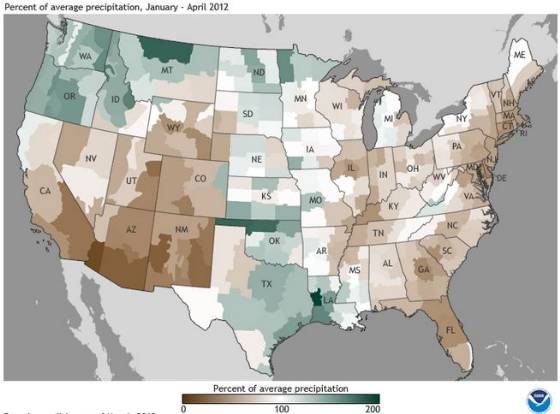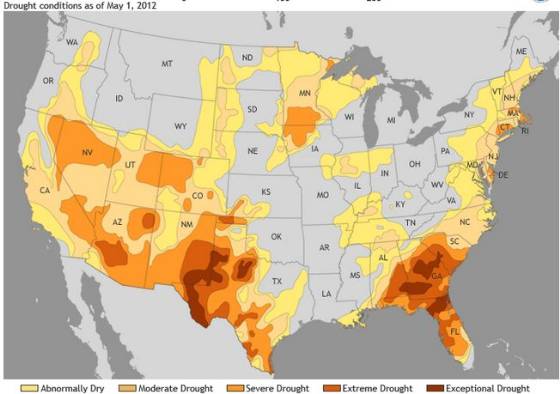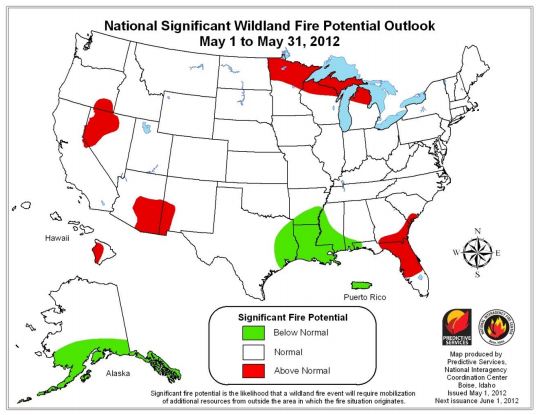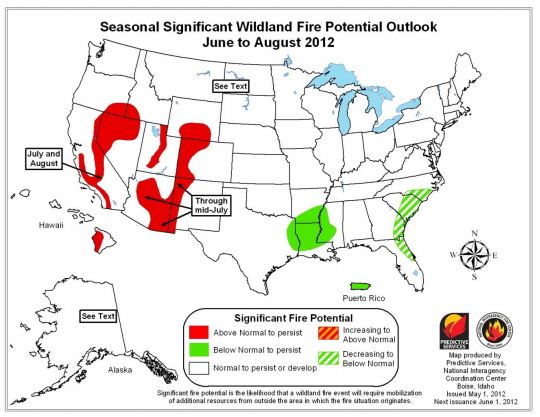Most of the United States is under some degree of drought, according to the U.S. Drought Monitor. And, much of the central part of the country is under “Extreme” or “Exceptional” drought.
Tag: weather
Critical fire weather for Wyoming and South Dakota
The South Dakota State Fire Meteorologist, Darren R. Clabo, distributed this weather statement Tuesday afternoon at 3:55 p.m. MT:
============================================================
“Critical fire weather conditions will continue through the afternoon today over eastern Wyoming and western South Dakota. The southern Black Hills may have the most critical conditions this afternoon with breezy winds and RHs below 15%.
A very windy day is in store for tomorrow as a strong cold front pushes through the state. Although temperatures will only reach the mid 70s and minimum RHs will likely not fall below 30% over West River areas, northwest winds will gust over 50 mph throughout the afternoon. A High Wind Warning has been issued for southern Meade, central/eastern Pennington, eastern Custer, and Shannon Counties in effect from 0600-1800 tomorrow (Wednesday 15 August). Wind gusts will likely exceed 35 mph over the rest of SD. With the cured fuels, fast moving fires are a possibility, especially in the grassland. Little precipitation is expected with this front (with the exception of southeastern SD).”
Lightning over Utah
Many areas of the Eastern Great Basin had lightning storms and passing rain showers yesterday; crews in southwestern and northern Utah were helped out a bit by light rainstorms. The Little Pine Fire, southwest of Enterprise on the Dixie National Forest, burned 2,100 acres and threatened about a dozen buildings. It’s burning in piñon-juniper, cheatgrass, and oak brush. A Type 3 team is assigned, and there’s currently zero containment. Evacuations were in effect yesterday.
The Pinyon Fire this week evacuated dozens of homes in Eagle Mountain and threatened the town of Herriman. Today it’s still at 60 percent containment at 5,771 acres. Late last evening, 35 mph winds from a passing storm caused numerous flare-ups, but containment lines held. Engine crews worked through the night on hot spots and mop-up; today they’re focusing on securing lines and mopping up.
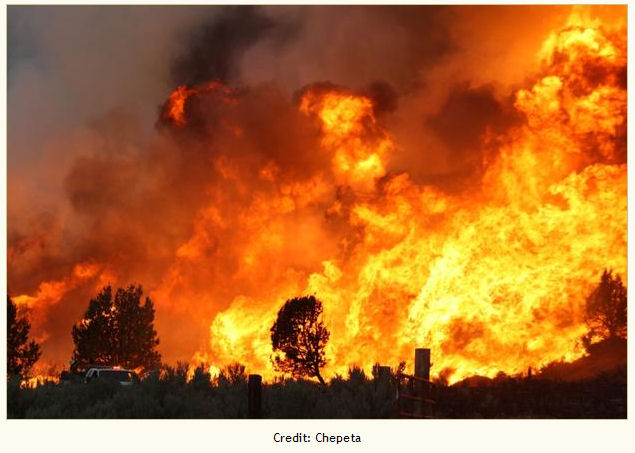
Gusty winds on Wednesday spread embers over the lines and more than doubled the size of the Pinyon Fire. It was about 60 percent contained yesterday, according to a report by the Salt Lake Tribune. Information Officer Kim Osborn said crews were mopping up as the fire continued creeping and smoldering. Fire managers were focused on keeping the fire away from a remote artillery training area on Utah National Guard property; hundreds of unexploded munitions are buried on the site.
On the DI Ranch Fire west of Utah Hill, gusty winds on Thursday shifted and pushed the fire from 75 percent containment back to about 50 percent. Last night it was back to 20 percent containment at 900 acres. The fire’s burning in brush and cheatgrass.
Critical fire weather expected in the Black Hills on Tuesday
 On Tuesday the Black Hills could experience dry lightning on what is expected to be the hottest day of the year so far. With temperatures above 100, relative humidity below 15 percent, and windy conditions, firefighters on Tuesday could be busy. In the southern Black Hills the 18 mph winds gusting to 28 could fan into life leftover lighting ignited fires from the mostly wet thunderstorms that passed through Monday afternoon and night.
On Tuesday the Black Hills could experience dry lightning on what is expected to be the hottest day of the year so far. With temperatures above 100, relative humidity below 15 percent, and windy conditions, firefighters on Tuesday could be busy. In the southern Black Hills the 18 mph winds gusting to 28 could fan into life leftover lighting ignited fires from the mostly wet thunderstorms that passed through Monday afternoon and night.
The South Dakota State Fire Meteorologist, Darren R. Clabo, distributed this message Monday afternoon:
======================================================
A very warm and dry week is expected with excessively critical fire weather conditions expect for West River and the Black Hills on Tuesday. A few showers and thunderstorm (mostly wet) will pass over the region tonight. Unfortunately, this also means lightning strikes on the eve of a critical fire weather day. The hottest day yet this year will occur tomorrow as a large amplitude upper level ridge builds into the region: highs will be at or above 100 degrees with RHs below 15%. In addition, a strong pressure gradient will develop over western SD in the afternoon leading to gusty southwesterly winds. To add insult to injury, enough instability will be present to warrant a threat for dry lightning for the Black Hills and surrounding plains. Red Flag Warnings are in place for this region. East River will see cooler conditions with highs in the 80s and 90s and RHs from 30-40%. Conditions wills moderate on Wednesday as an upper level trough skirts the area. Temperatures will be in the 80s and 90s with RHs between 20 and 30%. Northerly winds are expected. Similar conditions will be seen Thursday but far southwestern SD may have minimum RHs drop below 15%. Temperatures in the 80s and 90s with RHs from 20-30% are expected Friday and through the weekend. To summarize, very hot and dry fire weather conditions, more representative of late July and August, have arrived. (Darren Clabo)
Wildfire morning briefing, May 9, 2012
It is dry in much of the southwestern and eastern United States
Average precipitation, January through April, 2012:
Drought conditions as of May 1, 2012:
Escaped prescribed fires complicate future projects in Australia
Last year we first wrote about the prescribed fire in Leeuwin-Naturaliste National Park that escaped on November 23, 2011 and pushed by strong winds, destroyed 40 structures and burned over 8,400 acres in western Australia. Residents who had refused to evacuate later had to take refuge from the fire at the ocean on a beach. They were rescued by jet ski and ferried to a search and rescue boat offshore. The report on the incident was very critical of the government’s prescribed fire program, saying some employees of the Department of Environment and Conservation were overworked and performing above their skill levels.
A recent article in The Independent examines further the prescribed fire program in Australia in light of the recent failures. Here is an excerpt:
…A lobby group called the Bush Fire Front, which was set up by a group of retired foresters in western Australia, is also predicting dire consequences unless the burning programme is “greatly expanded”. The Front’s chairman, Roger Underwood, deplores a backlash against DEC’s staff, who have stopped wearing uniforms after being hissed at and abused in the Margaret River shops.
“DEC has been looking after their fire safety for years, doing all the dirty work,” says Mr Underwood. “They make one mistake and are crucified for it.”
However, as locals point out, it was not just one mistake. On the day of the fire, another controlled burn escaped near Nannup, east of Margaret River, incinerating 125,000 acres of national park and state forest, and damaging a farm part-owned by Stewart and Alison Scott. Mr Scott was about to start the afternoon’s milking when he saw flames sweeping towards his property. He dashed over to warn his family, but the smoke was so thick that one of his farmhands – who had leapt on a quad bike – collided with a car. The man suffered head injuries and spent months in Royal Perth Hospital.
California wildfire burns structures
A wildfire near Acton, California in southern California yesterday burned 126 acres and several structures. Inspector Quvondo Johnson of Los Angeles County Fire Department said an aggressive air attack, which included five helicopters and fixed wing air tankers, helped the crews on the ground contain the fire.
CAL FIRE sent S-2 air tankers from Porterville and Hemet, 120 miles and 90 miles from the fire, respectively. There were no federal air tankers at the air tanker base at Landcaster, 18 miles from the fire. The DC-10 very large air tankers are based at Victorville, 60 miles east of Acton.
Is fire suppression causing water shortages?
An opinion piece in the LA Times claims the 100-year old policy of wildfire suppression in the United States has caused water shortages. The theory is that over-stocked forests that have become that way due to successful suppression of fires, have locked up moisture in the trees and reduced runoff. Here is an excerpt from the article:
Today, the hottest and thirstiest parts of the United States are best described as over-forested. Vigorous federal protection has stocked semiarid regions of public land with several billion trees too many. And day after day these excess trees deplete a natural resource that has become far more precious than toilet paper or 2-by-4’s: water.
I will have to go on record as being skeptical of this trees-causing-water-shortage theory.
2011 summary of incident reviews
The Wildfire Lessons Learned Center has released a report summarizing the information gleaned from the seventy-eight 2011 incident review reports—from various agencies—submitted to and gathered by the LLC.
New Mexico establishes fire notification system
The state of New Mexico has established a system by which residents can be notified about wildfires. Emails will contain information including when the fire started, the cause, and a description of threatened homes and communities. For now, the system will send people who sign up for the service information about all fires within the state. Later it will be refined so that notifications can be filtered to more specific locations, such as counties. Anyone can sign up HERE.
Thanks go out to Johnny and Dick.
Wildfire potential, May through August, 2012
The Predictive Services section at the National Interagency Fire Center has issued their National Wildland Significant Fire Potential Outlook for May through August, 2012. If it is correct, June through August looks close to average for most of the United States, except for above normal potential for parts of the southwest and Colorado, Utah, Nevada, Hawaii, and California.
Significant Fire Potential
- Above Normal Significant Fire Potential is expected across most of the interior mountains and foothills of Southern California; the Sierras; much of northwestern and northern Nevada; southeastern Oregon; southwestern Idaho; the northern and central mountains of Utah; south central Wyoming; western Colorado; most of northwest, central and southeastern Arizona; western New Mexico; northern Minnesota; northern Wisconsin; northern Michigan; most of Florida; and extreme southern Georgia and southeastern South Carolina.
- Significant Fire Potential will decrease to below normal this summer along the East coast from North Carolina to central Florida.
- Below Normal Significant Fire Potential is expected for southern Alaska; Louisiana; southeastern Texas; southern Arkansas; southeastern Mississippi; far southwestern Alabama; and the western portion of the Florida Panhandle.
- The rest of the country will have normal significant fire potential.





